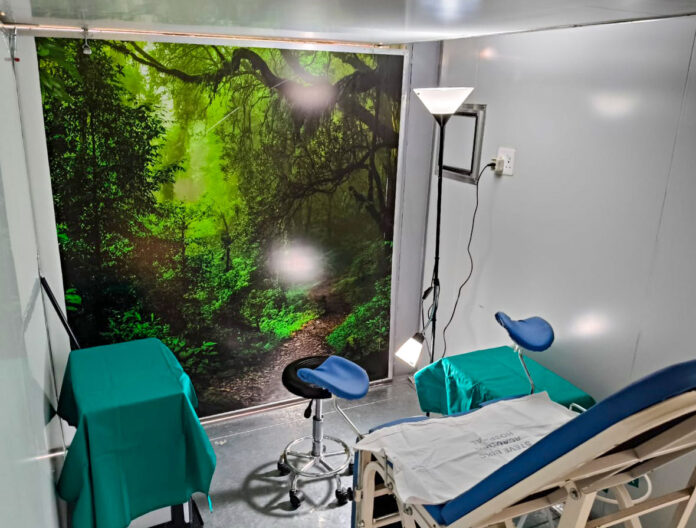This week I’m sending congratulations to two sets of parents in South Africa. Babies Milayah and Rossouw arrived a few weeks ago. All babies are special, but these two set a new precedent. They’re the first to be born following “simplified” IVF performed in a mobile lab.
This new mobile lab is essentially a trailer crammed with everything an embryologist needs to perform IVF on a shoestring. It was designed to deliver reproductive treatments to people who live in rural parts of low-income countries, where IVF can be prohibitively expensive or even nonexistent. And it seems to work!
While IVF is increasingly commonplace in wealthy countries—around 12% of all births in Spain result from such procedures—it remains expensive and isn’t always covered by insurance or national health providers. And it’s even less accessible in low-income countries—especially for people who live in rural areas.
People often assume that countries with high birth rates don’t need access to fertility treatments, says Gerhard Boshoff, an embryologist at the University of Pretoria in South Africa. Sub-Saharan African countries like Niger, Angola, and Benin all have birth rates above 40 per 1,000 people, which is over four times the rates in Italy and Japan, for example.
But that doesn’t mean people in Sub-Saharan Africa don’t need IVF. Globally, around one in six adults experience infertility at some point in their lives, according to the World Health Organization. Research by the organization suggests that infertility rates are similar in high-income and low-income countries. As the WHO’s director general Tedros Adhanom Ghebreyesus puts it: “Infertility does not discriminate.”
For many people in rural areas of low-income countries, IVF clinics simply don’t exist. South Africa is considered a “reproductive hub” of the African continent, but even in that country there are fewer than 30 clinics for a population of over 60 million. A recent study found there were no such clinics in Angola or Malawi.
Willem Ombelet, a retired gynecologist, first noticed these disparities back in the 1980s, while he was working at an IVF lab in Pretoria. “I witnessed that infertility was [more prevalent] in the black population than the white population—but they couldn’t access IVF because of apartheid,” he says. The experience spurred him to find ways to make IVF accessible for everyone. In the 1990s, he launched The Walking Egg—a science and art project with that goal.
In 2008, Ombelet met Jonathan Van Blerkom, a reproductive biologist and embryologist who had already been experimenting with a simplified version of IVF. Typically, embryos are cultured in an incubator that provides a sterile mix of gases. Van Blerkom’s approach was to preload tubes with the required gases and seal them with a rubber stopper. “We don’t need a fancy lab,” says Ombelet.
Eggs and sperm can be injected into the tubes through the stoppers, and the resulting embryos can be grown inside. All you really need is a good microscope and a way to keep the tube warm, says Ombelet. Once the embryos are around five days old, they can be transferred to a person’s uterus or frozen. “The cost is one tenth or one twentieth of a normal lab,” says Ombelet.
Ombelet, Van Blerkom, and their colleagues found that this approach appeared to work as well as regular IVF. The team ran their first pilot trial at a clinic in Belgium in 2012. The first babies conceived with the simplified IVF process were born later that year.
More recently, Boshoff wondered if the team could take the show on the road. Making IVF simpler and cheaper is one thing, but getting it to people who don’t have access to IVF care is another. What if the team could pack the simplified IVF lab into a trailer and drive it around rural South Africa?
“We just needed to figure out how to have everything in a very confined space,” says Boshoff. As part of the Walking Egg project, he and his colleagues found a way to organize the lab equipment and squeeze in air filters. He then designed a “fold-out system” that allowed the team to create a second room when the trailer was parked. This provides some privacy for people who are having embryos transferred, he says.
People who want to use the mobile IVF lab will first have to undergo treatment at a local medical facility, where they will take drugs that stimulate their ovaries to release eggs, and then have those eggs collected. The rest of the process can be done in the mobile lab, says Boshoff, who presented his work at the European Society of Human Reproduction and Embryology’s annual meeting in Paris earlier this month.
The first trial started last year. The team partnered with one of the few existing fertility clinics in rural South Africa, which put them in touch with 10 willing volunteers. Five of the 10 women got pregnant following their simplified IVF in the mobile lab. One miscarried, but four pregnancies continued. On June 18, baby Milayah arrived. Two days later, another mother welcomed baby Rossouw. The other babies could come any day now.
“We’ve proven that a very cheap and easy [IVF] method can be used even in a mobile unit and have comparable results to regular IVF,” says Ombelet, who says his team is planning similar trials in Egypt and Indonesia. “The next step is to roll it out all over the world.”
This article first appeared in The Checkup, MIT Technology Review’s weekly biotech newsletter. To receive it in your inbox every Thursday, and read articles like this first, sign up here.


